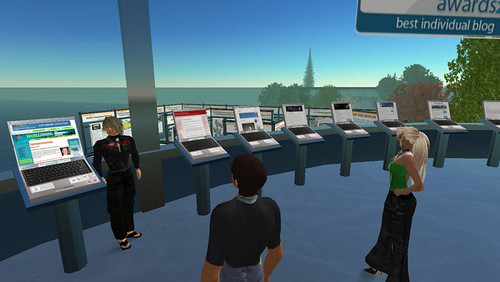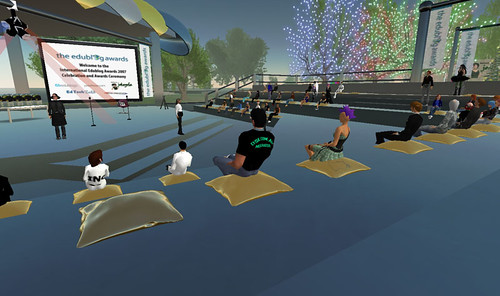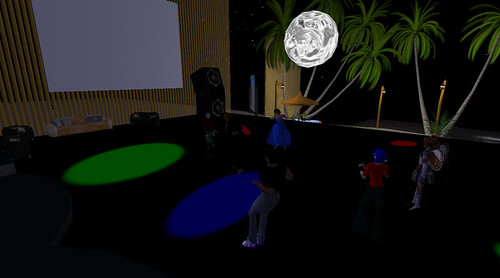My friend Anne Baird blogged today about her insights regarding the use of Creative Commons as a form of managing the usage rights to creative works such as music, pictures, video or writing. For many people, the only law they have ever heard of in regard to using the work of others is copyright law, and this is usually interpreted as “you cannot use this!” That’s not exactly correct of course… copyright means “you cannot use this without asking my permission”. Unfortunately the process of getting that permission is usually not so simple, so for most people the choice is to not use the work at all, or to use it illegally.
 Enter the world of Creative Commons. Creative Commons, or CC for short, was launched in 2001 and is a licensing model for defining how an artistic or intellectual work may (or may not) be used. It sits in that void between the restrictive copyright model and the free-for-all that is the Public Domain. Too often people assume that because they found something on the Web that they have carte blanche to use it any way they like. Not so. By default, every creative work is instantly and automatically covered by copyright as soon as the author creates it so the right to borrow, steal, reuse or adapt these works is automatically forbidden. Aside from the sometimes vague notion of “fair use” and some specific exceptions, you are generally NOT entitled to reuse someone else’s work without their express permission. Added to the sometimes seemingly illogical restrictions that copyright imposes are the significant variations in the way copyright law is applied from country to country, providing a recipe for general confusion about what you can and can’t do with someone else’s work.
Enter the world of Creative Commons. Creative Commons, or CC for short, was launched in 2001 and is a licensing model for defining how an artistic or intellectual work may (or may not) be used. It sits in that void between the restrictive copyright model and the free-for-all that is the Public Domain. Too often people assume that because they found something on the Web that they have carte blanche to use it any way they like. Not so. By default, every creative work is instantly and automatically covered by copyright as soon as the author creates it so the right to borrow, steal, reuse or adapt these works is automatically forbidden. Aside from the sometimes vague notion of “fair use” and some specific exceptions, you are generally NOT entitled to reuse someone else’s work without their express permission. Added to the sometimes seemingly illogical restrictions that copyright imposes are the significant variations in the way copyright law is applied from country to country, providing a recipe for general confusion about what you can and can’t do with someone else’s work.
Perhaps Creative Commons licensing can be best summed up from this description on their own website…
“Creative Commons defines the spectrum of possibilities between full copyright — all rights reserved — and the public domain — no rights reserved. Our licenses help you keep your copyright while inviting certain uses of your work — a “some rights reserved” copyright.
Too often the debate over creative control tends to the extremes. At one pole is a vision of total control — a world in which every last use of a work is regulated and in which “all rights reserved” (and then some) is the norm. At the other end is a vision of anarchy — a world in which creators enjoy a wide range of freedom but are left vulnerable to exploitation. Balance, compromise, and moderation — once the driving forces of a copyright system that valued innovation and protection equally — have become endangered species.”
There are also some excellent videos on the CC site which make it much clearer what Creative Commons licensing is all about, including this one…
[kml_flashembed movie="http://flash.revver.com/player/1.0/player.swf" width="480" height="376" fvars="mediaId=89072 ; affiliateId=44205" wmode="transparent" /]
If you look back the the development of art, architecture, design, cinema or literature of the last century, much of it was shaped by the ability to build on the work of those that went beforehand. Impressionist artwork inspired the Post-Impressionists, which in turn inspired others to create the movements of Cubism, Fauvism, Expressionism, Surrealism and Dada. Each of these movements was built on the ideas and work of those that preceded it. As Picasso noted, “Good artists copy, great artists steal”. Some of the most influential works of art in the last century were only possible because the artists were able to stand on the shoulders of those who came before them and build on their ideas. Some, like Marcel Duchamp, were able to change the course of artistic history with acts as simple yet profound as painting a moustache on Michaelangelo’s Mona Lisa, causing an entire generation of artists to deeply question the notion of what art was really all about. Indeed, the very notion of appropriation – using the work of those that came before you as a basis for you own work – is a fundamental characteristic of Post Modernism. And you have to ask yourself, if the notion of copyright as we understand it today had existed in the earlier part of this century, would we have had any of this intellectual and artistic explosion of ideas? Or would Picasso have been threatened with legal action after painting Le Demoiselles d’Avignon because it borrowed too heavily on the art of Africa, or the work of Georges Braque?
CC licensing adds some common sense back into the way content creators allow others to use their work. It adds some balance and moderation, letting content creators decide just how restrictive or not they wish to make the reuse of their work. We have allowed ourselves to become a society where we legislate against nearly everything, and in the process we have lost some of the humanity that goes along with sharing and spreading ideas and mentoring to the masses.
Many of the senior courses I have been teaching over the last few years have really harped at the students about the idea of respecting copyright, as they should. But I’m realising that I have not paid nearly enough attention to the alternatives to copyright such as Creative Commons or Copyleft. If you’ve also not paid attention to these alternatives, now is the time to start looking at them seriously.
By letting our children stand on the shoulders of the giants who came before them we give them a broader perspective and a deeper creative vision for the possibilities.

 What did intrigue me though was the notice I received to say that the
What did intrigue me though was the notice I received to say that the  The actual awards were held on Sunday morning at 8:30am Sydney time so my SL alter-ego, Outback Outlander, turned up with a handsome new look (thanks to some last minute shopping on Freebie Island) and took my seat at the awards auditorium with a whole lot of other very good looking avatars. The event was hosted by Jeff Lebow, James Farmer and Dave Cormier who did a great job of keeping it all moving along despite a couple of minor hassles with the audio streams. Considering it was being broadcast out to Second Life, UStream and Skype, it was a pretty impressive undertaking. Here are
The actual awards were held on Sunday morning at 8:30am Sydney time so my SL alter-ego, Outback Outlander, turned up with a handsome new look (thanks to some last minute shopping on Freebie Island) and took my seat at the awards auditorium with a whole lot of other very good looking avatars. The event was hosted by Jeff Lebow, James Farmer and Dave Cormier who did a great job of keeping it all moving along despite a couple of minor hassles with the audio streams. Considering it was being broadcast out to Second Life, UStream and Skype, it was a pretty impressive undertaking. Here are  When I told other people I know (who mostly don’t “get” this whole online world thing) that my blogs had been nominated for an award they congratulated me. When I told them the awards ceremony was going to held in a place that existed only inside a computer, populated by people who were represented only by virtual 3D characters, they looked at me as though I was nuts. When I heard people in-world saying that there was an awards after-party on the beach where there would be dancing and drinks, I started to wonder if I was nuts. Dancing and drinks?! C’mon! I mean, in my First Life I’m sitting in my study in front of my computer in my pyjamas on a Sunday morning and in my Second Life I’m heading to a virtual beach to drink virtual cocktails and dance under a virtual mirror ball? … I’m pretty geeky, but that is seriously bizarre stuff!
When I told other people I know (who mostly don’t “get” this whole online world thing) that my blogs had been nominated for an award they congratulated me. When I told them the awards ceremony was going to held in a place that existed only inside a computer, populated by people who were represented only by virtual 3D characters, they looked at me as though I was nuts. When I heard people in-world saying that there was an awards after-party on the beach where there would be dancing and drinks, I started to wonder if I was nuts. Dancing and drinks?! C’mon! I mean, in my First Life I’m sitting in my study in front of my computer in my pyjamas on a Sunday morning and in my Second Life I’m heading to a virtual beach to drink virtual cocktails and dance under a virtual mirror ball? … I’m pretty geeky, but that is seriously bizarre stuff!